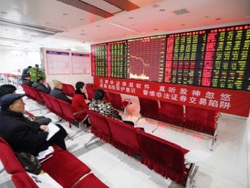
China faces the arduous task of organizing a soft landing of the economy after decades of startling growth. Skeptics abound, but don’t pay any attention to them. China has an advantage that is not available to other countries in storm conditions of today’s global economy, is a clear path forward. If China consistently and comprehensively will increase the level of performance, he will be able to overcome the challenges of economic growth, to reduce the threat of financial crisis and to complete the transition to an economy based on consumption. It will be a country with high income levels and large, wealthy middle class. In this scenario annual GDP by 2030, according to estimates, could be $5 trillion to exceed the level that would be achieved if the authorities will continue the current policy of growth through investment.
Actually China is not so rich choice. The traditional engines of economic growth — the large reserves of labor and large-scale investments in infrastructure, housing and industrial capacity — are beginning to run out of steam. The working-age population reached a peak of urbanization is slowing down, steel and cement industries are suffering from overcapacity. Since the profitability of the investment declines, the China can not rely on significant economic growth due to investment costs.
But, thankfully, China still has room to grow in the field of labor productivity: the level is only 10-30% of the level of developed countries. McKinsey Global Institute analyzed more than 2000 Chinese companies from different industries (coal, steel, automotive, retail and so on) and found different opportunities to increase productivity by 20-100% by 2030.
Take, for example, the Chinese service sector. Although this sector is growing rapidly and it now accounts for about 50% GDP, it still dominates the business with low added value. The performance of Chinese enterprises in the services sector makes up approximately 15-30% of the level of performance of similar companies in OECD countries. In addition to improving already existing business (for example, through the introduction of self-checkout in retail trade) China has the ability to create around its manufacturing sector business services with high added value, for example, in the field of design, accounting, marketing and logistics.
And in the manufacturing sector, China could be more actively involved in automation of factories. China is the world’s largest buyer of robots, but 10 thousand employees in the country accounted for only 36 robots, compared to 164 in the USA and 478 in Korea. Chinese companies have already demonstrated a willingness to use both automated and manual Assembly lines. In addition, they can improve performance by streamlining operations and improving energy efficiency, approaching in its business indicators to the level of global competitors.
Chinese companies are major producers in a broad range of industries, but they have yet to master those stages of production that create maximum added value. For example, in the case of semiconductors, Chinese enterprises generally play the role of suppliers to those companies engaged in designing and selling chips (and thus receive the bulk of the cost). Another example: the share of generic medicines account for 90% of sales of Chinese pharmaceutical industry.
China might use a variety of methods for innovation support, in particular, creating clusters of research and development. In addition, to help increase the income of the inventors is capable of strengthening the protection of intellectual property rights and reform of the process of bringing companies to the market. For example, in the pharmaceutical sector, the group of innovative companies hone a special Chinese approach to the creation of new drugs: the enormous and cheap technical talent. These companies have already embarked on the path of development of the more profitable business of branded medicines.
Perhaps the most serious prospects for increasing productivity are opened in those sectors where China has appeared excess capacity. Over the last decade because of these annual excess return on equity in the coal and steel industries declined from 17% to 6%. Chinese automotive industry is capable to produce 40 million vehicles per year, but market size of only $ 26 million. The restructuring of industries, like steel, in the form of consent to the bankruptcy of uncompetitive players and promoting industry consolidation would radically increase performance, without compromising ability to meet the demand.
As the transition of companies to the business with higher added value, will begin to appear millions of jobs with higher pay, and this will increase the income of households and increase the size of the Chinese middle class. However, in the first two or three years until revenue growth due to the effect of increasing labor productivity, large-scale reallocation of resources can lead to temporary difficulties. Have to retrain and move millions of low-skilled workers, while GDP growth may slow more than expected, before you go moderately fast, but sustainable rate of growth (up to 2030).
The alternative is maintaining the status quo: support of poorly performing companies for the sake of preserving jobs and social stability, despite the risks that Chinese banks. The country would be counter-productive use of resources, and the company will lose its global competitiveness.
The history of China gives reason to hope that the leaders will make the right choice. In 1990-ies the difficulties of the public sector and the Asian financial crisis threatened to drown the economy. However, the government embarked on fiscal and monetary stimulus to ensure growth in the short term and painful reforms that brought the country on the path to a stunning, double-digit economic growth, which has endured two decades.
Today China will take a similar decision. He can choose a policy of provisional measures, which ultimately only exacerbate the problem. Or can use the chance to make reforms that will increase productivity and ensure economic prosperity for years to come.








